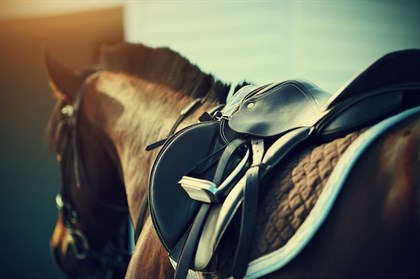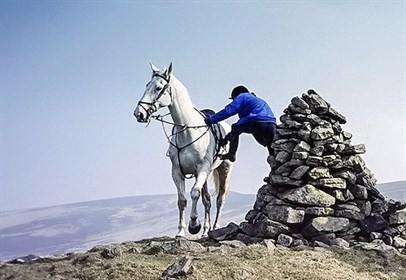|

|
This article first appeared in a previous edition of Equestrian Life magazine. To see what is in our latest digital issue, please click here.

Which side you mount your horse from is usually a matter of convention, but is there more to it? Here we present the cases for getting on either side of the horse… without taking sides!
BY IAN NORTHEAST
THE OFFSIDE CASE: have you ever tried getting on to your horse from the offside? Not easy, but it helps immensely in our quest for perfect balance. Here are five good reasons to mount from the offside.
1. To save your horse’s back.
Every time we mount we create a significant rotational force through our horse’s thorax. As the withers are pulled towards the side of mounting, the ribs on the same side are depressed, the sternum is pushed to the opposite side, the pectorals on the same side contract whilst the rhomboids and trapezius on the opposite side contract in an attempt to maintain balance, to name but a tiny fraction of the cascade of events. None of these responses are bad by any means, but it’s the repetition of the same sequence which contributes to laterality, an uneven horse and potentially pain and dysfunction. Spread the love. Mount both sides.
2. To improve your coordination.
While continually mounting from the same side affects our horse’s symmetry (his muscles, tendons and ligaments are repeatedly exposed to the same imbalanced stress), it also creates a sidedness to the rider who continually practices the same movement. Have you tried mounting on the opposite side lately? I know people who make a habit of it and would say it is a piece of cake, but for me, I nearly fell off the first time I tried! However, like all these things it takes practise, and something so simple will aid in our coordination and control of our body. It seems like a quite bizarre thing to be unable to do, don’t you think?
This simple task will aid our coordination, giving us the ability to do one motor task on both sides of our body and at the same time assist in our strength and mobility through our lower back and hips. The more tasks like this we can do, the greater our symmetry will be. Please do not take this as though “perfect symmetry” is the goal; it is not. We are meant to have sidedness; my hope here is that perhaps increasing this sidedness through routines we learnt as pony clubbers isn’t required as big kids.
3. To save your saddle’s tree.
We’ve looked at what happens to our horse and what happens to us, and now it’s time to look at what happens to the bit in between. What happens when we swing on a door too many times (doesn’t everyone do that still?)? Eventually it no longer fits snugly in the doorway. The saddle, which was created to fit like a lock and key, has now been warped and will be slowly creating spinal issues which turn into rib issues, which turn into shoulder and forelimb issues and then the whole horse is compromised. Our saddles are becoming better and better in their construction, however, small, repetitive forces over time can wreak spectacular changes. Why not save your horse’s back and your saddle at the same time?
4. To create variation in your horse’s experiences and neurological plasticity
There are mountains written on this topic, especially as it relates to horses -- an animal of prey that tends towards the flight response. Objects and events that are out of the ordinary can trigger the sympathetic nervous system (fight or flight response) and quieten our parasympathetic nervous system (rest and digest). The sympathetic nervous system suppresses our immune system, our repair and healing, and our digestive and reproductive systems while it dilates our pupils, sharpens our hearing and sends blood to our skeletal muscles in preparation for fight or, in the case of most horses, flight.
“I’ve enough trouble with that as it is. Why on earth would l want to create more of that?!”
There are lots of things that can contribute to a horse’s stress levels. From physical imbalances and pains (which is where I come in), to the environment (traffic, other horses, lack of shelter), to nutrition, illness and so on. These components all need to be addressed, and once done so, we need to slowly create variation in our horse’s life as a beautiful way of lessening its stress response whenever something out of the ordinary happens. It can be as easy as starting to mix up which side we mount from.
5. To improve your ability to adapt to your horse’s behaviour.
For whatever reason, our horse has hallucinated a reason to step sideways, backwards or around in circles, the flexibility to mount from either side can only be a benefit. Alternatively, in the likely scenario that you are faced with a Man From Snowy River event when the pack is galloping off and you've got to catch them to win the girl, then mounting your roan stock horse from the offside like a pro rather than stumbling around like a first-timer will look much more impressive!

Some of us need all the help we can get to mount our horse!
© Walter Baxter
BY KERRY MACK
THE NEAR SIDE: Why do we get on the horse from the near side? Firstly, because it's good for horses, and secondly, it's good for people. Here are five good reasons to mount from the near side.
1. Convention and history.
The reason horsemen started the convention of mounting from the near side was that soldiers carried swords on the left side so as to easily draw them with the right hand. If you have a sword on the left side it is easier to mount from the left, so the sword does not have to be lifted over.
2. We want our reins in the left hand.
If you have to use a gun or lance or something else in your right hand, then it's best to have your reins in the left hand. If you get on from the left, the reins will be in the left hand.
3. It’s easy for horses to understand.
Because of these first two reasons, getting on from the left is now the convention. Horses anywhere in the world understand this, and it helps them be confident about what is expected of them. Brains are structured in two halves joined together by a big band of white matter called the corpus callosum. Horses have quite a small corpus callosum. This means that the left side doesn't always know what the right side is doing. They don't generalise what happens from one side to the other. A horse that sees something spooky on one side won't always realise it's the same object seeing it on the other side. So it is much easier for the horse to have this convention.
4. It’s easy for riders to achieve fluency and competence.
Nerve cells that fire together wire together. We become more fluent and more balanced by repetition of a movement. The movement is more adaptable. So repetition of getting on from the left makes it easier for us to do it without pulling on the cantle, putting less pressure on the horse. We can also adapt if the horse moves around. We are more likely to have control of our bodies so that we don't stick our toes in the horse’s ribs. Our muscles also become stronger from the repetition, making it easier.
5. We are lazy.
There is no reason that we could not train our own horses and ourselves to mount both sides for all the very sound reasons that Ian gives. It just would take time and commitment and much repetition to become fluent on both sides. Perhaps we should mount an unknown horse from the near side, but train our own to do both. Always try to protect your horse’s back by using a step to get on, left hand with the reins on the neck and right hand on the pommel.
READ THE LATEST NEWS ARTICLES HERE

|

|

